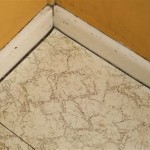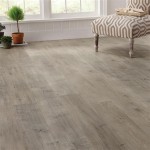Tongue and groove flooring is a popular choice for residential and commercial spaces due to its durability, aesthetic appeal, and relatively straightforward installation process. This type of flooring features interlocking edges, with a "tongue" on one side of each plank that fits snugly into the "groove" on the adjacent plank. This creates a tight, seamless surface that minimizes gaps and enhances stability. Proper installation is crucial to ensure a long-lasting and visually appealing floor.
Preparing for Tongue and Groove Flooring Installation
Before commencing the installation of tongue and groove flooring, meticulous preparation is essential. This phase directly impacts the final quality and longevity of the floor. Thoroughly assessing the subfloor, acclimating the flooring material, and gathering the necessary tools are critical steps.
Subfloor Inspection and Preparation
The subfloor serves as the foundation for the new flooring. Its condition significantly affects the stability and levelness of the finished surface. A comprehensive inspection should identify any existing issues, such as unevenness, moisture problems, or structural damage. Ideally, the subfloor should be constructed from plywood or oriented strand board (OSB), conforming to industry standards for thickness and quality.
Unevenness exceeding 3/16 inch over a 10-foot span should be addressed. Self-leveling compounds can be used to fill low spots and create a smooth, uniform surface. For more significant discrepancies, sanding, grinding, or the application of shims may be necessary. Verify that all fasteners, such as nails or screws, are securely in place and countersunk to prevent interference with the flooring installation.
Moisture content is a critical factor. Excessive moisture in the subfloor can lead to warping, cupping, or other problems with the finished flooring. Using a moisture meter, the moisture content of the subfloor should be tested. The acceptable level varies depending on the type of flooring being installed, but generally, it should be below 12%. If moisture levels are high, allow the subfloor to dry naturally or employ dehumidifiers to accelerate the process. It is also crucial to identify and address any sources of moisture, such as leaks or inadequate ventilation.
Once the subfloor meets the required specifications, thoroughly clean the surface. Remove any debris, dust, or existing adhesives that could impede proper adhesion or create an uneven surface. A vacuum cleaner with a brush attachment is suitable for removing loose particles. For stubborn residue, a scraper or appropriate solvent may be required.
Acclimating the Flooring Material
Acclimation is the process of allowing the tongue and groove flooring to adjust to the ambient temperature and humidity conditions of the installation environment. This step is crucial to prevent expansion or contraction of the flooring after installation, which can lead to gaps, buckling, or other problems. The acclimation period allows the wood to reach equilibrium with its surroundings.
The recommended acclimation period varies depending on the type of wood flooring, the geographic location, and the time of year. Generally, solid hardwood flooring requires a longer acclimation period than engineered wood flooring. Consult the flooring manufacturer's instructions for specific recommendations. As a general guideline, allow the flooring to acclimate for at least 72 hours.
During acclimation, store the flooring in the room where it will be installed. Spread the planks out in a single layer, allowing air to circulate freely around them. Avoid stacking the flooring tightly, as this will prevent proper acclimation. Maintain a consistent temperature and humidity level in the room during the acclimation period. Heating or cooling systems should be operational, and humidity levels should be within the normal range for the living space. Consistent acclimation is the bedrock for solid and secure floor boards.
Gathering Necessary Tools and Materials
Having all the necessary tools and materials on hand before starting the installation process streamlines the work and minimizes delays. A comprehensive toolkit includes measuring tools, cutting tools, fastening tools, and safety equipment.
Essential measuring tools include a tape measure, a chalk line, and a square. These tools are used to accurately measure the room, mark cutting lines, and ensure that the flooring is installed straight and square. A laser level can be helpful for establishing level lines, especially in larger rooms.
Cutting tools are used to cut the flooring planks to the required lengths and shapes. A circular saw is suitable for making straight cuts, while a jigsaw is useful for making curved or intricate cuts around doorways or other obstacles. A handsaw can be used for smaller, more precise cuts. Ideally, the saw blade should be specifically designed for cutting wood flooring to minimize splintering and chipping.
Fastening tools are used to secure the flooring planks to the subfloor. Depending on the type of flooring and the installation method, this may involve using nails, staples, or adhesives. A flooring nailer or stapler is specifically designed for installing tongue and groove flooring. These tools ensure that the fasteners are driven in at the correct angle and depth, without damaging the flooring. If using adhesives, choose a product specifically formulated for wood flooring and follow the manufacturer's instructions carefully.
Safety equipment is essential to protect against potential hazards during the installation process. Safety glasses should be worn at all times to protect the eyes from flying debris. A dust mask or respirator is recommended to prevent inhalation of dust particles. Hearing protection should be used when operating power tools. Knee pads can provide comfort and protection while working on the floor.
Other essential materials include spacers, which are used to maintain a consistent expansion gap between the flooring and the walls. Wood glue can be used to reinforce the tongue and groove connections. A tapping block and pull bar are used to tighten the seams between the flooring planks without damaging the edges. A moisture barrier, such as polyethylene film, may be required to protect the flooring from moisture rising from the subfloor. A finish, such as polyurethane or wax, may be applied to the flooring after installation to protect the surface and enhance its appearance.
Installing Tongue and Groove Flooring
The core of the project lies in the actual installation of the tongue and groove flooring. This involves careful alignment, secure fastening, and precise cutting to ensure a seamless and durable surface. The selection of an appropriate starting point, the method of fastening, and strategies for navigating obstacles are all important considerations.
Establishing a Starting Point and Laying the First Row
The selection of a suitable starting point is critical for ensuring that the flooring is installed straight and square. Ideally, the first row of flooring should be aligned with the longest straight wall in the room. Use a chalk line to mark a straight line parallel to the wall, allowing for an expansion gap of approximately ¼ to ⅜ inch. This gap allows for the natural expansion and contraction of the wood due to changes in temperature and humidity, preventing buckling or other problems.
Install the first row of flooring with the tongue facing the starting wall. This ensures that the groove will be exposed for the subsequent rows. Use spacers between the flooring and the wall to maintain a consistent expansion gap. Secure the first row to the subfloor using nails, staples, or adhesive, depending on the installation method. Ensure that the fasteners are driven in at the correct angle and depth to avoid damaging the flooring.
Check the alignment of the first row frequently using a square. If the row is not straight, make adjustments as needed before proceeding. A slight misalignment in the first row can be magnified as subsequent rows are installed, leading to a crooked or uneven floor. Consider using a laser level to project a straight line across the room to assist with the alignment of the first row.
Securing Subsequent Rows
Once the first row is securely in place, subsequent rows can be installed. Apply a small amount of wood glue to the tongue of each plank before inserting it into the groove of the adjacent plank. This reinforces the connection and helps to prevent squeaking or movement. Angle the plank slightly upward as you insert the tongue into the groove, then lower it into place. Use a tapping block and pull bar to tighten the seams between the planks. The tapping block protects the edge of the flooring from damage, while the pull bar allows you to apply leverage to close any gaps.
Stagger the end joints of the flooring planks to create a more visually appealing and structurally sound floor. Avoid placing end joints in adjacent rows directly across from each other. A minimum offset of 6 inches is recommended. This distributes the stress across the floor and prevents weak points.
Continue installing rows, working across the room. Check the alignment of the flooring frequently using a straight edge or level. Make adjustments as needed to ensure that the flooring remains straight and square. Remove any excess adhesive from the surface of the flooring immediately with a damp cloth.
Navigating Obstacles and Making Cuts
During the installation process, it will be necessary to navigate obstacles such as doorways, pipes, and other fixtures. Precise cutting is essential to ensure a neat and professional finish. Use a jigsaw to cut the flooring around these obstacles. Measure the distance from the wall to the obstacle, and transfer these measurements to the flooring plank. Use a square to mark the cutting lines, and carefully cut the plank using the jigsaw. It is often helpful to create a template using cardboard or paper to ensure an accurate fit.
For doorways, consider undercutting the door jambs and casings to allow the flooring to slide underneath. This creates a clean, professional look. Use a jamb saw to undercut the door jambs and casings to the required height. Be sure to remove any debris or obstructions from the area before installing the flooring. Around pipes and other fixtures, use a hole saw to drill a hole in the flooring plank that is slightly larger than the diameter of the pipe. This allows for expansion and contraction of the flooring without binding against the pipe.
Transitions between different types of flooring, such as carpet, tile, or vinyl, require the use of transition strips. These strips cover the gap between the two types of flooring and create a smooth, safe transition. Choose a transition strip that matches the color and style of the flooring. Install the transition strip according to the manufacturer's instructions.
Finishing Touches and Maintenance
Once the tongue and groove flooring is installed, a few finishing touches can enhance its appearance and protect it from wear and tear. Installing baseboards, applying a finish, and implementing a regular maintenance routine are all important steps.
Installing Baseboards and Trim
Baseboards and trim are installed along the perimeter of the room to cover the expansion gap and create a finished look. Choose baseboards and trim that complement the style of the flooring and the overall décor of the room. Miter the corners of the baseboards at a 45-degree angle for a clean, professional look. Attach the baseboards to the wall using nails or screws. Be careful not to drive the fasteners too deep, as this could damage the wall. Fill any nail holes with wood putty and sand smooth before painting or staining the baseboards.
Shoe molding can be installed along the bottom of the baseboards to cover any small gaps between the baseboards and the flooring. Shoe molding is typically smaller and more decorative than baseboards. Attach the shoe molding to the baseboards using nails or adhesive. Be careful not to nail the shoe molding to the floor, as this could restrict the expansion and contraction of the flooring.
Applying a Finish
Applying a finish to the flooring can protect it from scratches, stains, and moisture damage. Choose a finish that is appropriate for the type of wood and the level of traffic in the room. Polyurethane is a popular choice for wood flooring because it is durable, water-resistant, and easy to apply. Water-based polyurethane is a good option for those who are concerned about VOCs (volatile organic compounds). Apply the finish according to the manufacturer's instructions. Multiple coats may be required for optimal protection. Allow the finish to dry completely before walking on the floor.
Wax is another option for finishing wood flooring. Wax provides a natural, low-luster finish. However, wax is not as durable as polyurethane and requires more frequent maintenance. Apply the wax using a soft cloth and buff to a shine. Reapply wax as needed to maintain the finish.
Maintenance
Regular maintenance is essential to keep the tongue and groove flooring looking its best. Sweep or vacuum the floor regularly to remove dirt and debris. Use a damp mop to clean the floor as needed. Avoid using excessive water, as this could damage the wood. Use a cleaning product specifically designed for wood flooring. Avoid using harsh chemicals or abrasive cleaners, as these could damage the finish.
Place mats or rugs in high-traffic areas to protect the flooring from wear and tear. Use furniture pads under the legs of furniture to prevent scratches. Avoid wearing shoes with high heels or cleats on the flooring. These can damage the surface.
Periodically inspect the flooring for signs of wear and tear, such as scratches, dents, or water damage. Repair any damage promptly to prevent further deterioration. Scratches can often be repaired using a touch-up pen or wax stick. Dents can be steamed out using a damp cloth and an iron. Water damage should be addressed immediately to prevent mold and mildew growth.

Tongue Or Groove Which To Install First

All You Need To Know About Tongue And Groove Flooring Installation Reallyfloors America S Est Hardwood

How To Install Tongue And Groove Flooring Blog

5 Essential Tips For Tongue And Groove Flooring District Floor Depot

Home Owners Guide To Installing Tongue And Groove Flooring

Standard Tongue And Groove Flooring Installation

Tongue Groove Flooring Installation On Underlay Start To Finish

How To Install Hardwood Flooring Step By Forbes Home

Installation Guide How To Install Engineered Timber Flooring

How To Install Hardwood Flooring The Home Depot
Related Posts








